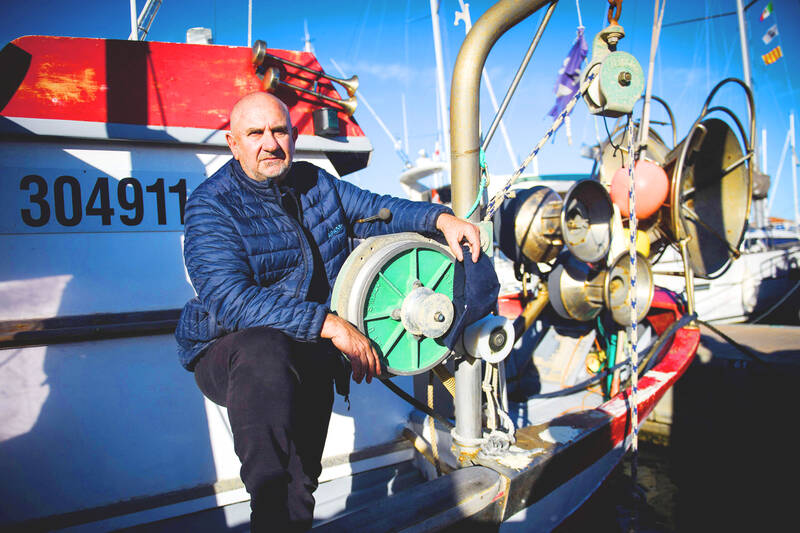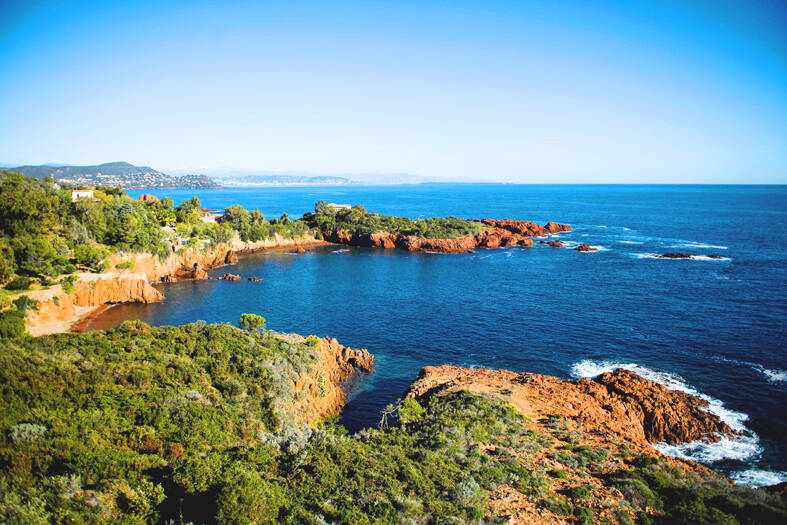A local fishing ban off the southern French coast has won praise from environmentalists and fishers alike, a rare example of biodiversity protection dovetailing with business interests.
Almost two decades after the ban, Cap Roux, a coastal tip of the Esterel mountain range near the commune of Saint-Raphael on the Mediterranean coast, is a biodiversity haven.
It stands in stark contrast to many other places on the Cote d’Azur where unbridled construction, overfishing and heavy shipping traffic have spoiled the once-pristine natural environment.

Photo: AFP
More than 80 species of marine life thrive off Cap Roux, attracted by meadows of seagrass and so-called “living rock” beneath the waves, a fusion of coral and algae.
Fishing here has been forbidden since 2004, a ban covering 450 hectares.
Surprisingly to some, local fishers called for the restriction, saying fish needed a safe place to breed and grow to renew stocks.

Photo: AFP
“Fishermen were worried about their future, and said: ‘Let’s find a space for a nursery that will replenish the surrounding waters,’” said Christian Decugis, Saint-Raphael’s first fishing mediator.
The fish sanctuary lies in the heart of an EU-protected reserve, chosen because it is a relatively unspoilt natural spot, far from the coast’s commercial ports.
“There would have been no point creating a reserve in an area that’s already been messed up,” Decugis said.
The ban has resulted in “many more fish and bigger fish, and an abundance of species,” he said — an observation backed by scientific studies and experiments.
Evidence shows the haven status has helped protect populations of grouper and corb, with scorpion fish and sea bream doing particularly well.
A 2017 study by the Association for Fisheries and Maritime Activities (APAM), which promotes sustainable fishing, said that income for fishers was “significantly higher” near the sanctuary than in zones farther away.
Beyond financial benefits, the new system also improves the reputation of the fishing community, which is often accused of having little concern for the consequences of relentlessly exploiting the sea’s resources.
“The image of a profession that is getting a handle on things and that thinks about tomorrow is very motivating for the fishermen,” Decugis said.
Not everyone is so protective of the restricted zone, with poachers tempted to plunder its healthy and plentiful fish supplies.
“It’s like an open treasure chest,” Decugis said.
Julia Toscano, comanager of the reserve, regularly goes out on a boat between May and September to check the no-fishing zone.
She calls police if she notices anything suspicious. Soon, she hopes there will be cameras to make the job easier.
Many tourists go fishing as they are unaware of the rules, but Toscano said that this is “still poaching.”
Regular campaigns inform visitors of the regulations and explain why the rich fishing grounds are off-limits, but it is a growing challenge: The number of tourists has shot up over the past three years.
Many come on big pleasure boats, typically more than 24m long.
The abundance of fish and colorful reefs also attract divers, who generate 500,000 euros (US$526,875) in income each year for local diving clubs, said Fabien Rozec, who runs the region’s marine life watchdog.
EU funds have enabled the clubs to get hold of eco-friendly buoys, so they no longer have to lower anchors on the fragile seabed.
Even pleasure boats have grown more cautious over the years, anchoring on patches of sand rather than underwater flora, Rozec said.

The US dollar was trading at NT$29.7 at 10am today on the Taipei Foreign Exchange, as the New Taiwan dollar gained NT$1.364 from the previous close last week. The NT dollar continued to rise today, after surging 3.07 percent on Friday. After opening at NT$30.91, the NT dollar gained more than NT$1 in just 15 minutes, briefly passing the NT$30 mark. Before the US Department of the Treasury's semi-annual currency report came out, expectations that the NT dollar would keep rising were already building. The NT dollar on Friday closed at NT$31.064, up by NT$0.953 — a 3.07 percent single-day gain. Today,

‘SHORT TERM’: The local currency would likely remain strong in the near term, driven by anticipated US trade pressure, capital inflows and expectations of a US Fed rate cut The US dollar is expected to fall below NT$30 in the near term, as traders anticipate increased pressure from Washington for Taiwan to allow the New Taiwan dollar to appreciate, Cathay United Bank (國泰世華銀行) chief economist Lin Chi-chao (林啟超) said. Following a sharp drop in the greenback against the NT dollar on Friday, Lin told the Central News Agency that the local currency is likely to remain strong in the short term, driven in part by market psychology surrounding anticipated US policy pressure. On Friday, the US dollar fell NT$0.953, or 3.07 percent, closing at NT$31.064 — its lowest level since Jan.

The New Taiwan dollar and Taiwanese stocks surged on signs that trade tensions between the world’s top two economies might start easing and as US tech earnings boosted the outlook of the nation’s semiconductor exports. The NT dollar strengthened as much as 3.8 percent versus the US dollar to 30.815, the biggest intraday gain since January 2011, closing at NT$31.064. The benchmark TAIEX jumped 2.73 percent to outperform the region’s equity gauges. Outlook for global trade improved after China said it is assessing possible trade talks with the US, providing a boost for the nation’s currency and shares. As the NT dollar

The Financial Supervisory Commission (FSC) yesterday met with some of the nation’s largest insurance companies as a skyrocketing New Taiwan dollar piles pressure on their hundreds of billions of dollars in US bond investments. The commission has asked some life insurance firms, among the biggest Asian holders of US debt, to discuss how the rapidly strengthening NT dollar has impacted their operations, people familiar with the matter said. The meeting took place as the NT dollar jumped as much as 5 percent yesterday, its biggest intraday gain in more than three decades. The local currency surged as exporters rushed to